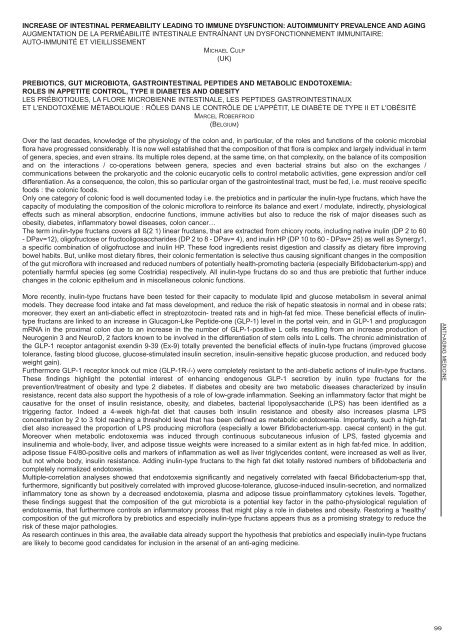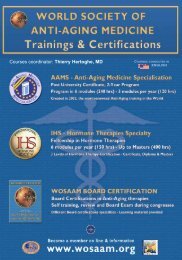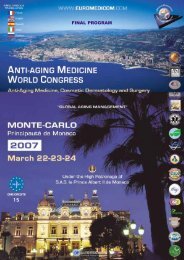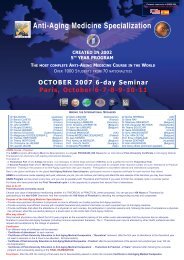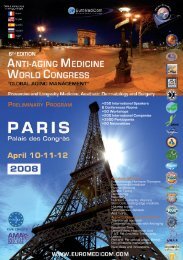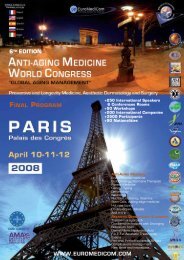FINAL PROGRAM 6TH EDITION - EuroMediCom
FINAL PROGRAM 6TH EDITION - EuroMediCom
FINAL PROGRAM 6TH EDITION - EuroMediCom
Create successful ePaper yourself
Turn your PDF publications into a flip-book with our unique Google optimized e-Paper software.
INCREASE OF INTESTINAL PERMEABILITY LEADING TO IMMUNE DYSFUNCTION: AUTOIMMUNITY PREVALENCE AND AGINGAUGMENTATION DE LA PERMÉABILITÉ INTESTINALE ENTRAÎNANT UN DYSFONCTIONNEMENT IMMUNITAIRE:AUTO-IMMUNITÉ ET VIEILLISSEMENTMICHAEL CULP(UK)PREBIOTICS, GUT MICROBIOTA, GASTROINTESTINAL PEPTIDES AND METABOLIC ENDOTOXEMIA:ROLES IN APPETITE CONTROL, TYPE II DIABETES AND OBESITYLES PRÉBIOTIQUES, LA FLORE MICROBIENNE INTESTINALE, LES PEPTIDES GASTROINTESTINAUXET L'ENDOTOXÉMIE MÉTABOLIQUE : RÔLES DANS LE CONTRÔLE DE L'APPÉTIT, LE DIABÈTE DE TYPE II ET L'OBÉSITÉMARCEL ROBERFROID(BELGIUM)Over the last decades, knowledge of the physiology of the colon and, in particular, of the roles and functions of the colonic microbialflora have progressed considerably. It is now well established that the composition of that flora is complex and largely individual in termof genera, species, and even strains. Its multiple roles depend, at the same time, on that complexity, on the balance of its compositionand on the interactions / co-operations between genera, species and even bacterial strains but also on the exchanges /communications between the prokaryotic and the colonic eucaryotic cells to control metabolic activities, gene expression and/or celldifferentiation. As a consequence, the colon, this so particular organ of the gastrointestinal tract, must be fed, i.e. must receive specificfoods : the colonic foods.Only one category of colonic food is well documented today i.e. the prebiotics and in particular the inulin-type fructans, which have thecapacity of modulating the composition of the colonic microflora to reinforce its balance and exert / modulate, indirectly, physiologicaleffects such as mineral absorption, endocrine functions, immune activities but also to reduce the risk of major diseases such asobesity, diabetes, inflammatory bowel diseases, colon cancer…The term inulin-type fructans covers all ß(2 1) linear fructans, that are extracted from chicory roots, including native inulin (DP 2 to 60- DPav=12), oligofructose or fructooligosaccharides (DP 2 to 8 - DPav= 4), and inulin HP (DP 10 to 60 - DPav= 25) as well as Synergy1,a specific combination of oligofructose and inulin HP. These food ingredients resist digestion and classify as dietary fibre improvingbowel habits. But, unlike most dietary fibres, their colonic fermentation is selective thus causing significant changes in the compositionof the gut microflora with increased and reduced numbers of potentially health-promoting bacteria (especially Bifidobacterium-spp) andpotentially harmful species (eg some Costridia) respectively. All inulin-type fructans do so and thus are prebiotic that further inducechanges in the colonic epithelium and in miscellaneous colonic functions.More recently, inulin-type fructans have been tested for their capacity to modulate lipid and glucose metabolism in several animalmodels. They decrease food intake and fat mass development, and reduce the risk of hepatic steatosis in normal and in obese rats;moreover, they exert an anti-diabetic effect in streptozotocin- treated rats and in high-fat fed mice. These beneficial effects of inulintypefructans are linked to an increase in Glucagon-Like Peptide-one (GLP-1) level in the portal vein, and in GLP-1 and proglucagonmRNA in the proximal colon due to an increase in the number of GLP-1-positive L cells resulting from an increase production ofNeurogenin 3 and NeuroD, 2 factors known to be involved in the differentiation of stem cells into L cells. The chronic administration ofthe GLP-1 receptor antagonist exendin 9-39 (Ex-9) totally prevented the beneficial effects of inulin-type fructans (improved glucosetolerance, fasting blood glucose, glucose-stimulated insulin secretion, insulin-sensitive hepatic glucose production, and reduced bodyweight gain).Furthermore GLP-1 receptor knock out mice (GLP-1R-/-) were completely resistant to the anti-diabetic actions of inulin-type fructans.These findings highlight the potential interest of enhancing endogenous GLP-1 secretion by inulin type fructans for theprevention/treatment of obesity and type 2 diabetes. If diabetes and obesity are two metabolic diseases characterized by insulinresistance, recent data also support the hypothesis of a role of low-grade inflammation. Seeking an inflammatory factor that might becausative for the onset of insulin resistance, obesity, and diabetes, bacterial lipopolysaccharide (LPS) has been identified as atriggering factor. Indeed a 4-week high-fat diet that causes both insulin resistance and obesity also increases plasma LPSconcentration by 2 to 3 fold reaching a threshold level that has been defined as metabolic endotoxemia. Importantly, such a high-fatdiet also increased the proportion of LPS producing microflora (especially a lower Bifidobacterium-spp. caecal content) in the gut.Moreover when metabolic endotoxemia was induced through continuous subcutaneous infusion of LPS, fasted glycemia andinsulinemia and whole-body, liver, and adipose tissue weights were increased to a similar extent as in high fat-fed mice. In addition,adipose tissue F4/80-positive cells and markers of inflammation as well as liver triglycerides content, were increased as well as liver,but not whole body, insulin resistance. Adding inulin-type fructans to the high fat diet totally restored numbers of bifidobacteria andcompletely normalized endotoxemia.Multiple-correlation analyses showed that endotoxemia significantly and negatively correlated with faecal Bifidobacterium-spp that,furthermore, significantly but positively correlated with improved glucose-tolerance, glucose-induced insulin-secretion, and normalizedinflammatory tone as shown by a decreased endotoxemia, plasma and adipose tissue proinflammatory cytokines levels. Together,these findings suggest that the composition of the gut microbiota is a potential key factor in the patho-physiological regulation ofendotoxemia, that furthermore controls an inflammatory process that might play a role in diabetes and obesity. Restoring a 'healthy'composition of the gut microflora by prebiotics and especially inulin-type fructans appears thus as a promising strategy to reduce therisk of these major pathologies.As research continues in this area, the available data already support the hypothesis that prebiotics and especially inulin-type fructansare likely to become good candidates for inclusion in the arsenal of an anti-aging medicine.ANTI-AGING MEDICINE99


